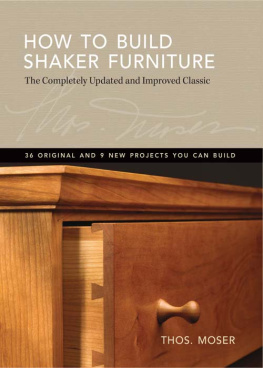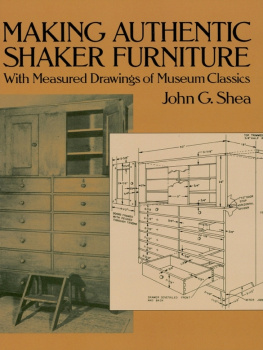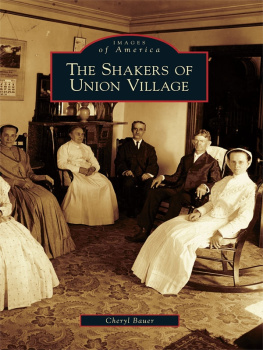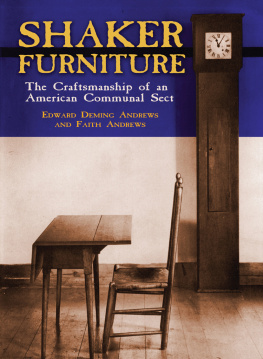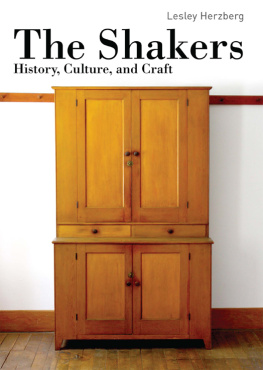Sign up for our newsletter and receive special offers, access to free content, and information on the latest new releases and must-have woodworking resources! Plus, receive a coupon code to use on your first purchase from ShopWoodworking.com for signing up.
READ THIS IMPORTANT SAFETY NOTICE
To prevent accidents, keep safety in mind while you work. Use the safety guards installed on power equipment; they are for your protection.
When working on power equipment, keep fingers away from saw blades, wear safety goggles to prevent injuries from flying wood chips and sawdust, wear hearing protection and consider installing a dust vacuum to reduce the amount of airborne sawdust in your woodshop.
Dont wear loose clothing, such as neckties or shirts with loose sleeves, or jewelry, such as rings, necklaces or bracelets, when working on power equipment. Tie back long hair to prevent it from getting caught in your equipment.
People who are sensitive to certain chemicals should check the chemical content of any product before using it.
Due to the variability of local conditions, construction materials, skill levels, etc., neither the author nor Popular Woodworking Books assumes any responsibility for any accidents, injuries, damages or other losses incurred resulting from the material presented in this book.
The authors and editors who compiled this book have tried to make the contents as accurate and correct as possible. Plans, illustrations, photographs and text have been carefully checked. All instructions, plans and projects should be carefully read, studied and understood before beginning construction.
Prices listed for supplies and equipment were current at the time of publication and are subject to change.

HOW TO BUILD SHAKER FURNITURE. Copyright 2011 by Thomas Moser. Printed and bound in China. All rights reserved. No part of this book may be reproduced in any form or by any electronic or mechanical means including information storage and retrieval systems without permission in writing from the publisher, except by a reviewer, who may quote brief passages in a review. Published by Popular Woodworking Books, an imprint of F+W Media, Inc., 4700 East Galbraith Road, Cincinnati, Ohio, 45236. (800) 289-0963 First edition.
Distributed in Canada by Fraser Direct
100 Armstrong Avenue
Georgetown, Ontario L7G 5S4
Canada
Distributed in the U.K. and Europe by F&W Media International, LTD
Brunel House, Forde Close
Newton Abbot
Devon TQ12 4PU
UK
Tel: (+44) 1626 323200
Fax: (+44) 1626 323319
E-mail:
Distributed in Australia by Capricorn Link
P.O. Box 704
Windsor, NSW 2756
Australia
Visit our Web site at www.popularwoodworking.com.

Other fine Popular Woodworking Books are available from your local bookstore or direct from the publisher.
15 14 13 12 11 5 4 3 2 1
ACQUISITIONS EDITOR: David Thiel
DESIGNER: Brian Roeth
PRODUCTION COORDINATOR: Mark Griffin
PHOTOGRAPHERS: Al Parrish, Thos. Moser Cabinetmakers staff, and as specified.
ILLUSTRATOR: Len Churchill
ABOUT THE AUTHOR

Growing up in Chicago, Tom Moser learned to work with his hands from his father, a stereotyper for the Chicago Tribune. Toms parents died when he was young, and at age 17 he dropped out of Northbrook High School to join the Air Force during the Korean War. While in high school, Tom met Mary Wilson, whom he married in 1957.
Tom credits the companys success to his partnership with Mary, and throughout their marriage the two have continued to pursue their love for furniture. During the early years of their marriage, Tom and Mary supplemented their income by purchasing old furniture, refinishing it in their home workshop, and reselling it.
Toms personal interest in the art of language persuaded him to return to school where he earned a bachelors of science degree in Speech Education from the State University of New York. After graduation, he began teaching English at Ann Arbor (MI) High School. In the next four years, he earned both his masters degree and a doctorate in Speech Communications from the University of Michigan, and taught at state colleges in Ypsilanti, Michigan and Cortland, New York.
In the mid-1960s, Tom, Mary and their four young sons spent a year in Dhahran, Saudi Arabia, where Tom taught English as a second language. The year away from his workshop profoundly affected Tom, and he realized how much he missed the craft of woodworking. Upon returning to the United States, Tom taught at the University of Maine, Orono and then at Bates College in Lewiston, Maine.
In 1972, Tom left his tenured professorship to turn his woodworking hobby into a career. In February 1972 Tom and Mary launched Thos. Moser Cabinetmakers.
What began as an intense exploration of craftsmanship an experiment has evolved into a business that employs more than 135 people, and has residential, professional and academic customers worldwide.
Forty years later, Tom remains active in the business, along with three of his four sons. He is also working on sculpture, and served on several non-profit boards, including the Maine Maritime Museum and Maine Employers Mutual Insurance Company.
ACKNOWLEDGEMENTS
Special appreciation must be extended to Steven Foster and the Shakers of Sabbathday Lake, Maine, who were so kind in providing the pictures of their truly magnificent collection. Also thanks to two who are, sadly, no longer with us: the late Sam Pennington of the Maine Antiques Digest and Edwin Boyker, cabinetmaker, friend and teacher. Kind thanks to Nick Roth, master craftsman and builder of fine wooden boats; Bill Huston, cabinetmaker and advisor; David Thiel of F+W Media; Janet Tinker of Thos. Moser Cabinetmakers; and lastly my wife Mary, who has taught me most of what I know about good taste.
THOS. MOSER | AUBURN, MAINE | 2011

Foreward to the New Edition
Its been thirty-four years since this book was first published. Much has changed in those years in woodworking technology for both amateurs and professionals. The level of interest in wood craftsmanship that exists today has never been greater. While industrial furniture making has migrated from the U.S. to China and the rest of Asia, participation in amateur woodworking has grown exponentially. Strange, isnt it that the more our economy turns its back on manufacturing (now fewer than 14% of us make things for a living, whereas when this book was first published that percentage was double), the more important it seems for us to create objects of beauty and utility. I firmly believe that as a species we define ourselves in large part by the products of our hands. By imposing upon natural materials intelligence, energy and imagination we assert our humanity. High technology does not alter this. Living in a world devoid of craftsmanship, a virtual world, does not nourish the soul. Imagination can be made real through the enhancement of natural materials and a commitment that beauty flows from aesthetic, indeed divine inspiration.

